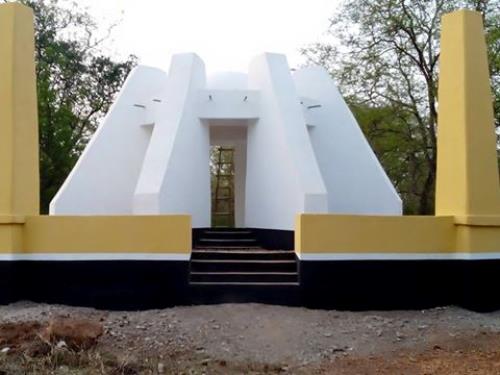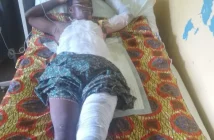For the African in the Diaspora searching for his roots, castles on the coast may serve as the remaining reference points of departure for their ancestors, but the Northern Region is the most likely place to trace his ancestry.
Nowhere in the country can you find more ancient slave markets and relics than in the Northern Region. The cultural features of the people in the North are as unique as they are diverse and so different from any other in and around the country. These include festivals and religion. Salaga for example was described as the emporium of West African trade at the height of its glory.
Below are key places with astounding historic background in the Northern region.
BUIPE:
By the main north-south highway from the national capital through Kumasi you cross the Black Volta into the Northern Region at Buipe which is also the terminal port of the Volta Lake Transport Service from Akosombo in the south to the north. In Buipe (Gbipe) precisely at its old site is located the tomb of the Great NdewuraJakpa the Gonja King who conquered, founded and consolidated Gonjaland. This tomb has now been redeveloped into a major tourist attraction.
A visit to the site will involve extensive interpretation on the design and rational for the tomb and its historical and heritage significance. The northwest journey brings the visitor to Damongo, the District Capital of West Gonja and the traditional capital of the paramount chief of the Gonjas with the title Yagbon Wura. Two very important stops or detours can be made before getting to Damongo. DABOYA: This town across the White Volta off the main road to Damongo is perhaps one of the most unique craft villages in West Africa.
It is a town known for Fugu (smock) the hand- woven striped cloth worn mainly by the people of the northern part of Ghana. From the spinning of the yarn to the weaving strips, every stage is done by hand and it is the main occupation of the majority of the inhabitants. Daboya is also accessible from Tamale through Tolon.
At Larabanga:
The ancient mosque and mystery stone have featured in every tourist guidebook. The people of this village, known as the kamaras, are descendants of the Muslim cleric who gave NdewuraJakpa spiritual protection during wars.
Legend has it that he threw a spear and where it landed was where he built the mosque some 400 years ago. He also left behind a Quran just as old as the mosque reputed to have been sent down by an angel.
This trio of mystics is completed by a stone, which cannot be moved. Thus the road from Larabanga toward the Upper West Region had to be constructed around the stone leading to sharp meandering bends around the stone.
BUSUNU:
Slave raiders mainly from the Sahel Region of Mali and Niger raided and terrorized tribes in Gonjaland. One of the most notorious was Samori. In 1896 a dispute over the succession to the Gonja Paramountcy between the Kong and Bole Divisions of the Gonjaland turned into a war.
The Kong people then sought the help of two infamous slave raiders – Samori from Guinea and Babatu from Côte d’Ivoire. These two mercenary groups massacred a large number of people before they themselves were defeated at the Battle of Jentilpe where a mass grave still exists. The Bole division eventually won the war when the remnants of the Gonjas retreated to Busunu where they made a standoff and defeated the mercenaries.
If you seek adventure away from the crowded city, then the northern region is the ideal destination for you. The combination of the variety of eco- tourism assets, relics of the slave trade against the background of diverse and very different culture is providing the draw for the increasing number of the energetic and courageous finding their way to Tamale.
MOLE NATIONAL PARK
Mole National Park is the country’s premier park for game viewing and perhaps the most important single attraction in the northern region. It was established in 1958 and re- designated as a National Park in 1971. Covering about 4577kmsq of undulating terrain with steep scarps, pristine guinea savannah vegetation and gallery forest along the rivers and streams, the park is home to almost 90 animal species notable among them being elephants, buffalo, roan, kob, hartebeest, waterbucks, warthogs, and 4 primate species. Lions, leopard and hyenas also occur and over 300 bird species have been recorded.
The park is largely located in the West Gonja district, about 143km (96miles) west of Tamale, on the Tamale-Wa trunk road. How to get there: A Metro Transit Bus runs a daily trip to the Park, Wa and Damongo. The Wa bus leaves in the morning about 5:30am daily (alight in Larabanga and charter a taxi); while the Damongo bus leaves in the morning daily at 6am (taxis abound to charter to the Park).
A private transport operator A.Y. Transport runs daily trips from Tamale to the park at 1pm – the station is located behind the Kaladan Park on the Picorna Hotel road’. You can also drive there with your private vehicle. One could also rent vehicles Tamale. GPRTU buses also run daily services on the road to Damongo and Wa.
Visitors may be taken on safari at any time between the 6:30am and 3:30pm on request Visitors to Mole also have the opportunity of exploring an eco- village at Mognori, which undoubtedly offers a true eco-village experience in tune with nature. Located 15 km on the south eastern boundary of the Mole National Park, the “Eco–Village experience” involves experiencing culture and traditions.
Major activities one can enjoy include:
• Day and overnight canoe safaris; for adventurous minded visitors
• Mognori village walk; you will learn about and participate in the traditional healing methods, shea butter processing and many more. Buffaloes in Mole National Park
KPARIA WATERFALLS AND COMMUNITY TOURISM:
Kparia is a community located to the north of the Mole National Park in the overseas area of the North Gonja District. There is a perennial waterfall located very close to the community but within the Park. Accessibility is currently difficult except for explorers and drifters. However, it holds great potential to attract tourists to the community and the waterfall.
Kparia tourism circuit has diverse tourism products which makes the attraction very appealing and fulfilling to both eco tourist and cultural tourists. These include the waterfalls (Kparia and Polzen within Mole Park), caves, bird watching, game viewing, historical settlement and community cultural heritage.
Another site visitors to the Northern Region cannot afford to miss is the Sonyo Community, showcasing “Traditional lifestyle and architecture”. Located 15km east of the district capital, Bole, on the Bole Secondary School road, Sonyo has a unique traditional architecture built in the ancient times to protect the community from their enemies.
Interestingly, most of the households do not have entry points at the base of their houses. They are only accessible to each other by walking on top of the roof using traditionally manufactured ladder to ascend and descend into the households. A Journey westwards takes the tourist some 100km from Larabanga to Bole.
With the help of a guide and a hired canoe you can paddle to the grazing hippos some 5km downstream. However, with construction of the Bui Dam, this is likely to affect the hippo sanctuary and other flora and fauna located in the area. Kulmasa is also noted for its traditional myths and beliefs.
It is located in the Sawla-Tuna-Kalba district 55km from Sawla, on the Wa-Kumasi highway. Kulmasa’s traditional myths and beliefs are centered on crocodiles. Visitors to kulmasa would experience how the locals co-exist in harmony with the crocodiles.
THE SLAVE TRADE HERITAGE
Anyone of African descent living abroad who is looking for his roots needs to go beyond the castles on the coast. They have to come to the northern region specifically to Salaga where the biggest of the slave markets of the 17th to 19th century was located.
Some of the relics of that period, which remain virtually intact in Salaga, are the hundreds of wells, which supplied water to the millions of merchants, slaves and beasts of burden; the market place, the bath troughs and the warehouses. Other towns with remnants of the slave trade include Yendi, where the tomb of Babatu, one of the notorious slave raiders can be found near his house.
His descendants still have his arms and amulets as heirloom. The Dagombas have a truly turbulent history and this is reflected in sites to be seen around Yendi. At the outskirts of the town is a hollowed tree with a rock nearby. The Dagombas fought several wars defending themselves or expanding their territories.
In the centre of the town are cemeteries for Germans and British who colonized that part of Ghana during the scramble for Africa. The cemeteries are an indication that they did not have it easy. At Adibo Dali, near Yendi is the field of a battle fought by the Dagombas against the Germans in 1890. Slave well site at Saakpuli in the Savelugu District.
The graves of the Dagomba warriors are close by the field where they fell and a tree on top of which their General directed their strategies. Side attractions in the south eastern trail are the Greenwich Meridian line in Yendi and the bird watching site at Sabari on the Oti River.
SITES IN AND AROUND TAMALE
Tamale is a relatively new town which at the turn of the last century was just a cluster of villages known mainly for the numerous shea butter trees- the ‘tama’ – from which it got the name Tamale. In 1907 it became the capital of the Northern Province of the British colony of the Gold Coast. The north played a very important role in the 2nd world war.
Two of the vestiges of the period are the old barracks and the old airport, which were built for military purposes. In addition to these is the monument to the royal wedding between King George V and Queen Elizabeth I located in the Gardens opposite the Jubilee Park.
The regional capital is also the commercial hub with virtually all the financial institutions operating and offering the services required by the travelling public. Some of the major banks include Standard Chartered Bank, Barclays Bank, GCB Bank, Agricultural Development Bank, National Investment Bank, Bank of Africa, Fidelity bank, Guarantee Trust Bank, Stanbic Bank, HFC Bank, EcoBank Ghana, UniBank, Access bank, Zenith Bank including the Bank of Ghana to mention a few.
All the insurance companies are also operating here to cater for your needs. All the banks also offer foreign exchange services. Even though the region is not a main stream shopping centre, there are shopping malls and outlets that can cater for the shopping needs of travellers and tourists alike.
For the cultural tourist, Jakarayili and Kukuo, suburbs of Tamale will be rewarding, as they are centres for traditional weaving and pottery and other community life style encounters. Weaving can also be observed at the Tamale and Aboabo Markets and recently along the major roads in town. Some Vernacular architecture in the northern region
Traditional Architecture of the North The north is noted for leather ware and the place to see the complete chain of activities involved from tanning raw cowhide to finished sandals, bags, belts or boots is Zongoni along the Buipela road. The artisanal blacksmiths who make simple tools, musical instruments and bangles can be found at Sabongida.
Shea butter is the raw material for body creams. Production of this important cream from the shea fruit is undertaken in villages around Tamale and all districts. All these traditional crafts and products can be bought in all the markets around the town but the best places to see these crafts are the Centre for National Culture and Aboabo Market.
In spite of its status as the fastest growing city in West Africa and the fourth-largest regional capital, Tamale is unique in the coexistence of centuries’ old traditional culture and modernity, typified by the modern office blocks standing side by side with old round huts with conical thatch along the major roads. Other cultural features to be observed in Tamale are the numerous shrines spread in all major traditional quarters such as Choggu, Nyohini and Vittin.
The “Pulipuon” tree at the Tamale Teaching Hospital lends credence to the power of shrines as recounted by adherents. However, to get a more practical benefit of shrines, which are usually only used for divination you have to travel some 24km to Tali near Tolon where a sacred grove has been used to create centuries old virgin vegetation around a shrine, the Jaagbo shrine, which serves as a sanctuary for birds and wildlife. A mystery tree near the Jaagbo shrine is reputed to have been climbed by a warrior on a horseback.
The hoof prints of a horse are still visible on the tree. To get a better insight into our culture groups can arrange to pay courtesy calls on any traditional chief, such as the chief of Tamale, the Dakpema; the Yaa Naa’s representative, the Gulkpe Naa, the Lamashegu Naa or the Sagnarigu Naa. Better still get lessons in culture and dance at the Centre for National Culture or at the Youth Home in Tamale. Research into the culture of the people can also be done at the Tamale Institute for Cross Culture Studies (TICCS).
It is not by any means all tradition and culture in Tamale. The central business district is a modern avenue of shops lined along carriageways and so you have the choice to shop for all your needs or sit in a bar for a cold drink or eat in a restaurant or a ‘chopbar’- traditional catering outlets where you can savour the local delicacies like TZ, Wasawasa, Tuugbani etc.
There are a few swimming pools and tennis courts where one can cool down from the heat and exercise if need be. Savelugu District is located 24km north of Tamale. It is accessible by a first class road and it offers cultural, natural and historical attractions for travelers. This is the district from which the cradle of Dagbon kingdom had its first capital at YeniDabari. The shrine of NaaSitobu.
The Savannah Agricultural Research Institute (SARI), the University for Development Studies (UDS) at Nyankpala and the Ghana Danish Community Programme (GDCP) at Dalon are major institutions of learning and research in the district. The main campus of the only University in the North – University for Development Studies is located in Tamale, with other campuses in Nyankpala, Navrongo and Wa. The school offers undergraduate, graduate and PhD programmes to both local and international students.
Other institutions include the Tamale Polytechnic, Teacher Training Colleges and the technical University College of Tamale. Main Administration Building of UDS in Tamale
SAAKPULI SLAVE SITE
Saakpauli is a village 7km off the Tamale- Bolgatanga trunk road at Disiga. This village was one of the several slave markets in the northern region. The market took place under a large baobab tree, which still stands today. Other relics are the old wells used by the people and slave merchants for cooking and drinking. Others include the remains of the stone foundation of ancient Saakpuli settlements. Traders from the north mostly Muslims exchanged tobacco and slaves for kola nuts and other merchandised goods from the south.
In the 19th century, Babatu and Samori the notorious slave raiders were known to have sold slaves at the market when they raided communities in the north, south and upper territories of Ghana and Burkina Faso.
WEST MAMPRUSI DISTRICT (WALEWALE)
The hilly, physical features coupled with the rolling savannah vegetation make the Karimenga area one of the most scenic landscapes. Trekking in this environment with boat rides on the White Volta and Nasia is a treat for the Nature lover.
WETLANDS
West Mamprusi District is famous for its ‘overseas’ area. This is an area crisscrossed by many rivers, which over flow their banks and create a vast lake-like feature. Nasia River also creates a similar Wetland during the rainy season.
This has made the whole of West Mamprusi a thriving sanctuary for both indigenous and migratory birds. There is also spring water at Jaringa near Kpasenkpe which cascades down rocks like a waterfall. A Forest Reserve created as a sacred grove in Duu, harbour wild life.
EAST MAMPRUSI AND BUNKPURUGU/YUNYO DISTRICT Gambaga Escarpment is the highest point in the northern region.
It has breath-taking views and offers opportunities for hiking on nature trails especially at Nakpanduri where there is a beautiful small seasonal waterfall and a garden around what used to be a rest house for the first president of Ghana Osagyefo Kwame Nkrumah.
The Nakpanduri end of the scarp has some amazing steep cliff surfaces which could be potential sites for paragliding and abseiling, while the rolling hills and forest cover provides opportunities for hiking and camping. The White Volta separates the Mamprusi land from the Upper East Region. It provides avenue for trekking and boat cruises.
HISTORICAL ATTRACTIONS
Naa Jaringa Wall. Naa Jaringa was a powerful Mamprusi chief who built a mighty wall around Nalerigu as his own memorial. It was built in the 15th century allegedly with honey, milk and sometimes human blood.
Only about 50 meters of the 10ft tall wall still remains.
Naa Atabia’s Grave. The great king fought and expanded the Mamprusi kingdom. He was the greatest king of the Mamprusi.
REFERENCE
1. Available online at, https://www.ghana.travel/places-to-visit/regions/northern/#:~:text=The%20history%20of%20Northern%20Region,in%201884%20for%20the%20British.




